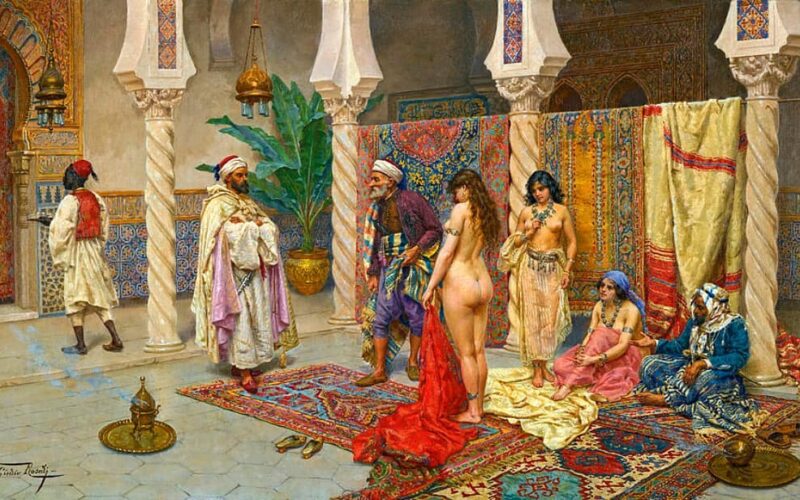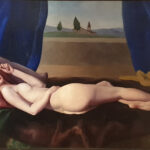The 19th century marked the rise of Orientalism in Western art. This movement, imbued with a fascination for the exotic ‘East’, offered artists an escape from the rigid moral norms of the Victorian era.
Developed during a period of rapid colonial expansion, Orientalism thrived on the enchantment and mystery of the East. The West, encountering cultures and societies that were until then distant and enigmatic, found in the ‘Other’ a powerful catalyst for artistic imagination, generating an entire genre dedicated to depicting the multifaceted aspects of the East in all its manifestations.
In Western art, the East was often portrayed as an adventurous and exotic place, full of vibrant colors, spicy aromas, opulent costumes, and imposing architecture. Women were commonly painted as beings of exotic beauty, while men were depicted as proud warriors or mysterious sages. Although these representations were often based on stereotypes and prejudices, they offered a fascinating alternative to the familiar and less exotic reality of the West.
Orientalism also represented an escape from the rigid moral norms of the Victorian era. Victorian society’s emphasis on respectability and virtue severely limited artistic freedom, especially regarding the depiction of sexuality and nudity. The East, with its supposed ‘decadence’ and ‘liberty’, provided artists with a context in which to explore these themes in ways that would have been deemed unacceptable in the Western context. Thus, Orientalism served as an outlet for the repressive tensions of Victorian society, allowing artists to challenge the limits imposed by the morals of the time.
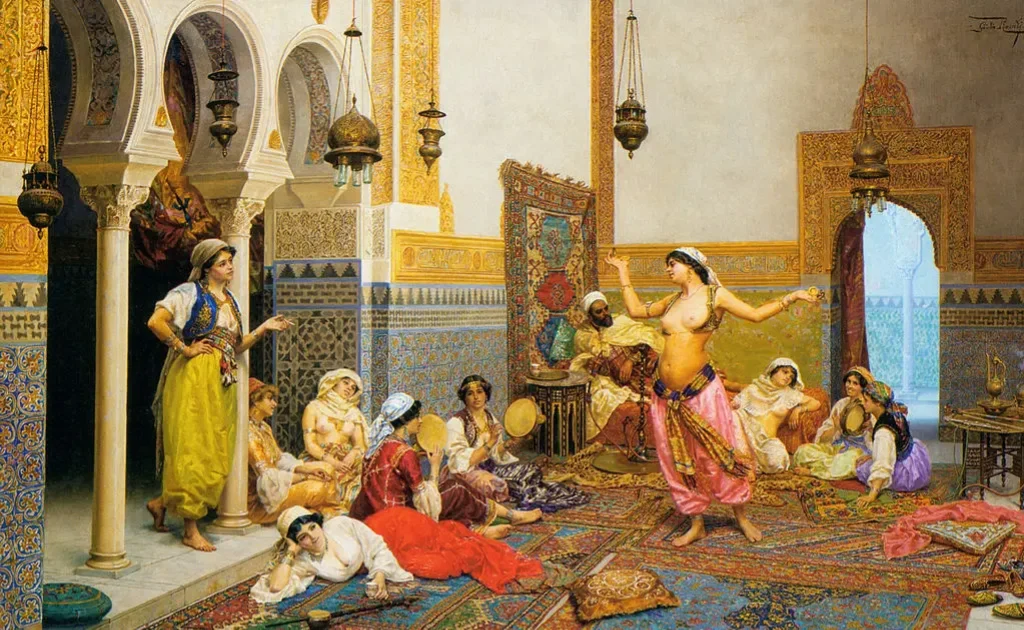
Taking a closer look, we can see how the works of Rosati, Marinelli, Rochegrosse, and Gérôme use Orientalist art as a vehicle to deeply probe themes of eroticism, desire, and possession. These artists, breaking away from the rigid confines of Victorian propriety, have exposed a worldview that mixes exotic allure with bold and liberating sensuality.
Giulio Rosati’s paintings “The Choice of the Favorite” and “Dance in the Harem” offer an intriguing glimpse into the life of harems as imagined in the West of the 19th century. Rosati is known for his paintings that depict harem life with great detail and richness of color, bringing to life scenes of sensuality and eroticism.
“The Choice of the Favorite” depicts a scene where the master of the harem is about to make his choice among several women. The women, all adorned with rich clothes and jewelry, await his judgment anxiously. Despite being in a situation of submission, these women are represented with a certain dignity and grace, contributing to an atmosphere of controlled sensuality.
“Dance in the Harem”, on the other hand, presents a festive scene in the harem. A dancer performs in the center of the room, while other women watch her admiringly. The painting is rich in detail and color, helping to create an atmosphere of exoticism and luxury. The dancer, with her elegant and seductive movements, becomes the focus of desire and attention.
In both paintings, Rosati offers a voyeuristic view of a world of exotic beauty and forbidden pleasures. However, the women in these paintings are not mere objects of desire. On the contrary, they are represented as active subjects of their own sexuality. Despite being in a situation of submission, these women are depicted with dignity and strength, challenging the gender roles established by Victorian society.
These paintings, with their detailed and sensual depiction of harems, reflect the complexity and ambivalence of Orientalism. While they celebrate the exoticism and sensuality of the East, these paintings also question the limits and expectations of Victorian society regarding gender and sexuality.
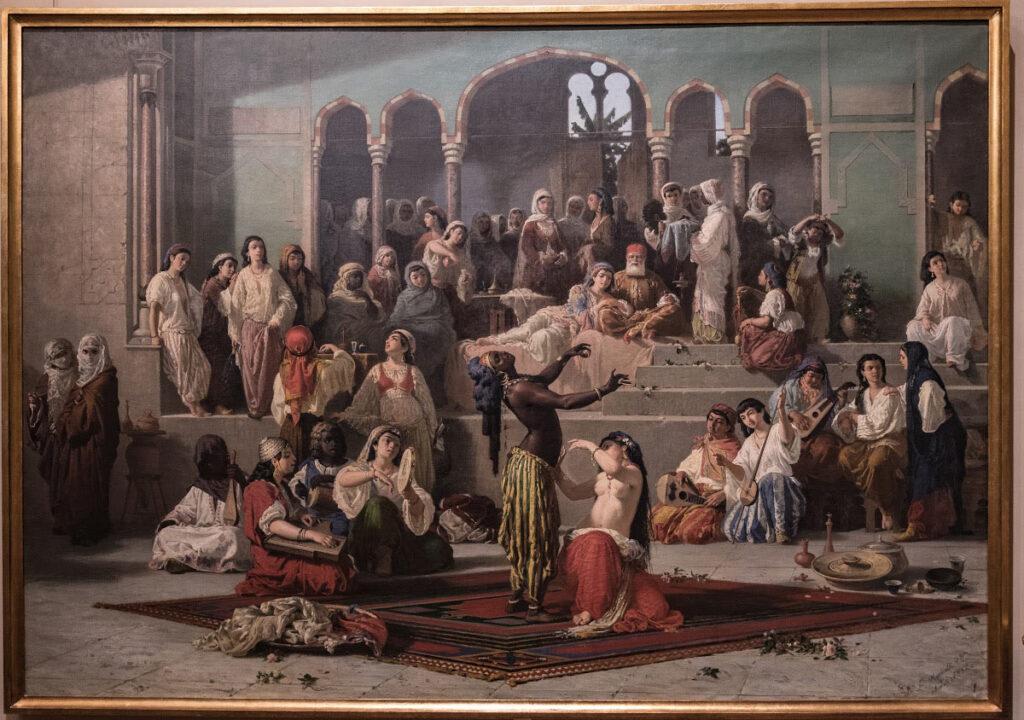
In Vincenzo Marinelli’s “Bee Dance in the Harem”, there is a palpable tension that reflects the desire and allure of the ‘different’. The painting depicts a dancer in the heart of a harem, surrounded by women and musicians, in a richly decorated room that evokes Oriental opulence.
The central dancer, portrayed in the midst of an ancient seductive dance, is the focal point of the painting. Her supple body, fluid movements, and glittering dress transform her into a symbol of desire and fascination. She is not just an object of observation but also controls the scene, as she draws the attention of all present. Her power lies in her charisma, her dancing talent, and her ability to capture attention.
The scene illustrates a world where female sensuality is celebrated and not repressed. This celebration contradicts the Victorian norms of the time that sought to confine sexuality and desire within rigid and often repressive limits. The female figures in Marinelli’s work, however, escape this confinement and move freely, demonstrating their pleasure and sensuality.
The tension in the painting arises not only from the seductive dance but also from the interaction between the dancer and the others present. The expressions on the faces of the other women vary from fascination to desire, and each seems to be emotionally involved in the action. This complexity adds depth to the work and suggests a tangled game of power, desire, and fascination.
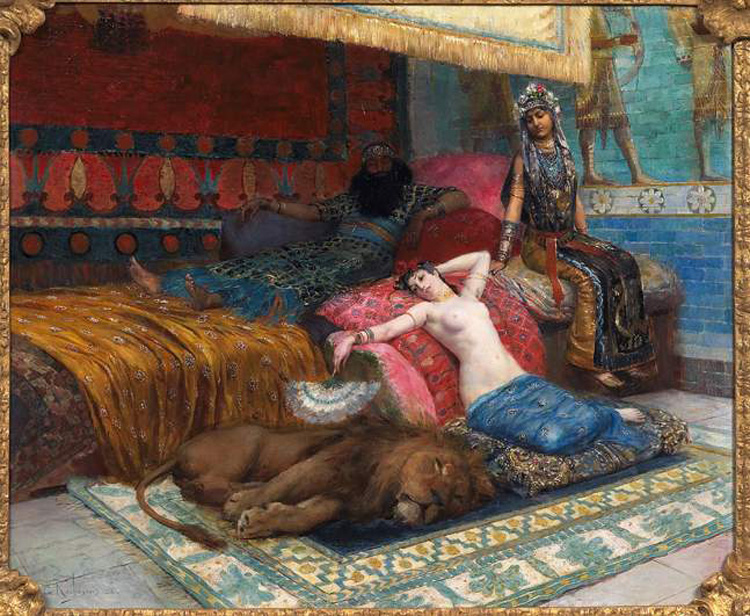
Georges Rochegrosse’s “The Slave and the Lion” depicts a very emotional and evocative scene. In the painting, a naked slave lies on a carpet next to a sleeping lion. Her position next to the lion, a powerful and dangerous animal, amplifies her vulnerability and her condition of submission.
The artist has used the contrast between the naked figure of the slave and the sleeping lion to create a palpable tension. The slave appears vulnerable yet radiant, her naked body exposed not only to the viewer’s gaze but also to the powerful predator sleeping beside her. This creates a sense of imminent danger, a tension that is almost palpable.
Despite the presence of the lion, the slave does not seem terrified. Her expression is thoughtful, perhaps resigned to her fate. This suggests that her condition of slavery is something she has become accustomed to, or has accepted as part of her life.
The interaction between the slave and the lion also creates an intriguing power play. The lion, a symbol of strength and power, is asleep and therefore temporarily defenseless, while the slave, normally in a position of submission, seems to have gained some control over the situation.
Rochegrosse has used the language of Orientalist art to explore themes such as sexuality, power, submission, and danger. His painting reflects the tensions and ambivalences of Orientalism and invites us to reflect on the complex dynamics of power and desire.
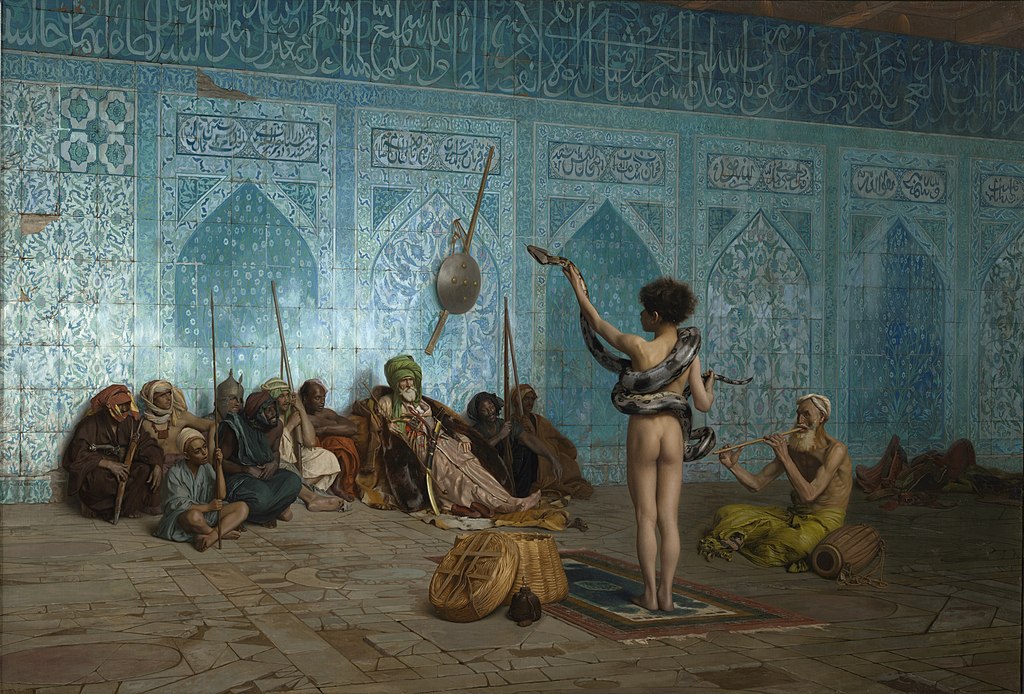
Finally, Jean-Léon Gérôme’s “The Snake Charmer” shows a young nude hypnotizing a snake. The boy’s nudity, as well as the dangerous nature of the act itself, adds an erotic element to the painting, a bold call to lost innocence and emerging sexuality.
The work evokes an atmosphere of emotional tension, where the desire for possession intertwines with the allure of the unknown. The boy, although a street performer, is presented as an exotic and mysterious subject, enchanting the snake and at the same time the audience.
This painting, like many others in Orientalist art, reflects a certain ambivalence. On one hand, there is an admiration for the beauty and innocence of the young, highlighted by the artist’s choice to represent him nude. On the other hand, there is a desire for possession of the subject, manifested in the voyeuristic representation of the boy and the fascinated reaction of the spectators.
This desire for possession is a constant in Orientalist art, linked not only to the desire to conquer the exotic and the different but also to own the otherness, to make it one’s own. It is a desire that, while problematic in its objectification of the other, contributes to creating works of great emotional intensity and artistic charm.
Each of these works shows a desire to possess not only the physical subject but also the exoticism and freedom that these subjects represent. The Orientalist art of the 19th century thus offers an interesting perspective on how desire, possession, and sexuality were explored through the prism of the ‘Other’.
These works, with their subtle eroticism and the representation of a society freer than the Victorian one, express a desire for escape and possession. Each explores the complex reciprocal interaction between desire, power, and otherness, reflecting the cultural and social tensions of their time.

